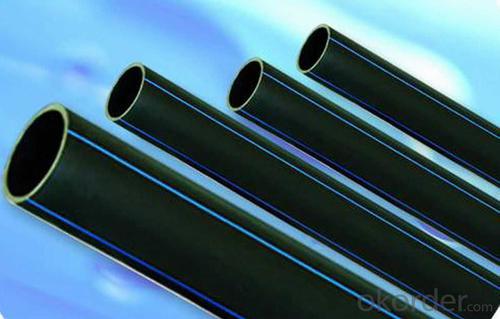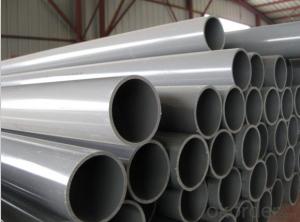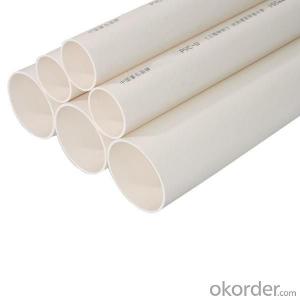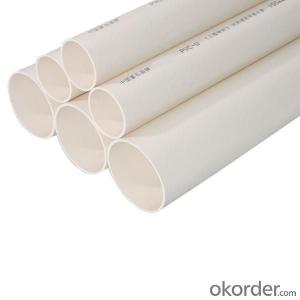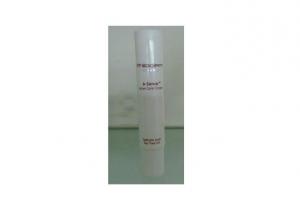HDPE Plastic Tubes ISO4427-1996
- Loading Port:
- China Main Port
- Payment Terms:
- TT OR LC
- Min Order Qty:
- -
- Supply Capability:
- -
OKorder Service Pledge
OKorder Financial Service
You Might Also Like
Physical properties[edit]
Polyethylene is a thermoplasticpolymer consisting of long hydrocarbon chains. Depending on the crystallinity and molecular weight, a melting point and glass transition may or may not be observable. The temperature at which these occur varies strongly with the type of polyethylene. For common commercial grades of medium- and high-density polyethylene the melting point is typically in the range 120 to 180 °C (248 to 356 °F). The melting point for average, commercial, low-density polyethylene is typically 105 to 115 °C (221 to 239 °F).it is transprant.
Chemical properties[edit]
Most LDPE, MDPE and HDPE grades have excellent chemical resistance, meaning that it is not attacked by strong acids or strong bases. It is also resistant to gentle oxidants and reducing agents. Polyethylene burns slowly with a blue flame having a yellow tip and gives off an odour of paraffin. The material continues burning on removal of the flame source and produces a drip.[3] Crystalline samples do not dissolve at room temperature. Polyethylene (other than cross-linked polyethylene) usually can be dissolved at elevated temperatures in aromatic hydrocarbons such as toluene or xylene, or in chlorinated solvents such as trichloroethane or trichlorobenzene.[4]
GB/T13663-2000:
| PE63管材规格 | |||||
| 公称 外径dn,mm | SDR33 | SDR26 | SDR17.6 | SDR13.6 | SDR11 |
| 公称压力 PN,Mpa | |||||
| 0.32 | 0.4 | 0.6 | 0.8 | 1.0 | |
| 公称 壁厚 | 公称 壁厚 | 公称 壁厚 | 公称 壁厚 | 公称 壁厚 | |
| 16 | 2.3 | ||||
| 20 | 2.3 | 2.3 | |||
| 25 | 2.3 | 2.3 | 2.3 | ||
| 32 | 2.3 | 2.4 | 2.9 | ||
| 40 | 2.3 | 2.3 | 3.0 | 3.7 | |
| 50 | 2.3 | 2.9 | 3.7 | 4.6 | |
| 63 | 2.3 | 2.5 | 3.6 | 4.7 | 5.8 |
| 75 | 2.3 | 2.9 | 4.3 | 5.6 | 6.8 |
| 90 | 2.8 | 3.5 | 5.1 | 6.7 | 8.2 |
| 110 | 3.4 | 4.2 | 6.3 | 8.1 | 10.0 |
| 125 | 3.9 | 4.8 | 7.1 | 9.2 | 11.4 |
| 140 | 4.3 | 5.4 | 8.0 | 10.3 | 12.7 |
| 160 | 4.9 | 6.2 | 9.1 | 11.8 | 14.6 |
| 180 | 5.5 | 6.9 | 10.2 | 13.3 | 16.4 |
| 200 | 6.2 | 7.7 | 11.4 | 14.7 | 18.2 |
| 225 | 6.9 | 8.6 | 12.8 | 16.6 | 20.5 |
| 250 | 7.7 | 9.6 | 14.2 | 18.4 | 22.7 |
| 280 | 8.6 | 10.7 | 15.9 | 20.6 | 25.4 |
| 315 | 9.7 | 12.1 | 17.9 | 23.2 | 28.6 |
| 355 | 10.9 | 13.6 | 20.1 | 26.1 | 32.2 |
| 400 | 12.3 | 15.3 | 22.7 | 29.4 | 36.3 |
| 450 | 13.8 | 17.2 | 25.5 | 33.1 | 40.9 |
| 500 | 15.3 | 19.1 | 28.3 | 36.8 | 45.4 |
| 560 | 17.2 | 21.4 | 31.7 | 41.2 | 50.8 |
| 630 | 19.3 | 24.1 | 35.7 | 46.3 | 57.2 |
- Q: Can plastic tubes be used for storing pharmaceuticals?
- Yes, plastic tubes can be used for storing pharmaceuticals.
- Q: Can plastic tubes be used for fire extinguishing systems?
- Yes, plastic tubes can be used for fire extinguishing systems. However, it is important to note that the specific type of plastic used must be fire-resistant and comply with safety regulations. Additionally, proper installation and maintenance are crucial to ensure the effectiveness and reliability of the fire extinguishing system.
- Q: There is a white plastic tube outside the tank. How can I use it?
- That hose is outside the fish tank outside the water level, so that bubbles will emerge (that is, bubbles generated in the water and designed). If you put it in the water, you won't get bubbles.
- Q: How do plastic tubes compare to nylon tubes in terms of strength?
- Plastic tubes and nylon tubes have different properties, but in terms of strength, nylon tubes are generally considered to be stronger than plastic tubes. Nylon has a higher tensile strength and is more resistant to impact, making it suitable for applications that require durability and toughness.
- Q: Are plastic tubes safe for food and beverage applications?
- Yes, plastic tubes are generally safe for food and beverage applications. However, it is important to note that the safety depends on the type of plastic used and its compliance with food-grade standards. Food-grade plastics, such as polyethylene and polypropylene, are commonly used for manufacturing tubes that come into contact with food and beverages. These plastics are non-toxic, resistant to chemicals, and can withstand the necessary temperatures for food and beverage applications. Additionally, it is vital to ensure that the plastic tubes are properly cleaned and maintained to prevent any contamination.
- Q: I need to connect some flexible plastic tubing to a hard plastic nozzle both 3/8 outer diameter. It needs to be able to be attached and detached easily (like screwing it in or something), and the seal between them needs to be water tight. Anybody have any ideas? Are there any couplers that can do this easily?. I'd rather not thread the inside of the hard plastic nozzle, but if thats the only way, how do I do that?
- they make a great coupler called a SHARK BITE. Go to home depot to get them. Easy on and off as you need
- Q: Can plastic tubes be customized?
- Yes, plastic tubes can be customized. They can be manufactured in various sizes, shapes, and colors to meet specific requirements. Customization options include printing logos or labels, adding caps or closures, and adjusting the thickness and material composition.
- Q: How can the PPR pipe be connected with the metal tube?
- In the PP-R piping system, the transition between the metal pipe and the plastic pipe needs a transition piece, the transition piece and the PP-R pipe are connected by hot melt, and the transition part is connected with the metal pipe through a screw thread.
- Q: What is the diameter range of plastic tubes?
- The diameter range of plastic tubes can vary greatly depending on their intended use and manufacturing process, but it typically ranges from a few millimeters to several inches.
- Q: Do plastic tubes have any limitations in terms of clarity or transparency?
- Yes, plastic tubes do have limitations in terms of clarity or transparency. While many plastic tubes are designed to be clear or transparent to some extent, they may not provide the same level of clarity as glass or other materials. Some plastic tubes may have a slightly hazy or cloudy appearance, which can affect the visibility of the contents inside. Additionally, certain plastics may become discolored over time or when exposed to certain chemicals or UV light, further affecting their clarity. However, advancements in plastic technology have led to the development of highly transparent tubes that offer excellent clarity.
Send your message to us
HDPE Plastic Tubes ISO4427-1996
- Loading Port:
- China Main Port
- Payment Terms:
- TT OR LC
- Min Order Qty:
- -
- Supply Capability:
- -
OKorder Service Pledge
OKorder Financial Service
Similar products
Hot products
Hot Searches
Related keywords

